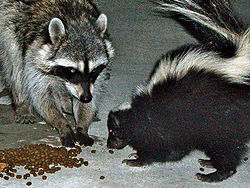
The mesopredator release hypothesis is an ecological theory used to describe the interrelated population dynamics between apex predators and mesopredators within an ecosystem, such that a collapsing population of the former results in dramatically increased populations of the latter. This hypothesis describes the phenomenon of trophic cascade in specific terrestrial communities.
A mesopredator is a medium-sized, middle trophic level predator, which both preys and is preyed upon. Examples are raccoons, skunks,[1] snakes, cownose rays, and small sharks.
- ^ Helgen, K.; Reid, F. (2016). "Mephitis mephitis". IUCN Red List of Threatened Species. 2016: e.T41635A45211301. doi:10.2305/IUCN.UK.2016-1.RLTS.T41635A45211301.en. Retrieved 12 November 2021.